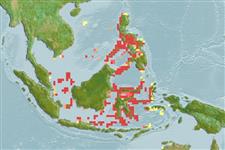>
Gobiiformes (Gobies) >
Gobiidae (Gobies) > Gobionellinae
Etymology: Pandaka: Sanskrit, pandaka = without testicles, hermaphrodite, homosexual; it is a Philippines fish, the smallest of the world.
More on author: Herre.
Environment: milieu / climate zone / depth range / distribution range
Ecología
marino; salobre demersal; rango de profundidad 0 - 2 m (Ref. 90102). Tropical
Western Central Pacific.
Tamaño / Peso / Age
Maturity: Lm ? range ? - ? cm
Max length : 1.7 cm SL macho / no sexado; (Ref. 439); 1.6 cm SL (female)
Short description
Claves de identificación | Morfología | Morfometría
Espinas dorsales (total) : 6 - 7; Radios blandos dorsales (total) : 6 - 7; Espinas anales: 1; Radios blandos anales: 6 - 7. Characterized by black and white color pattern; middle of caudal fin base with black spot; translucent yellow fins except male first dorsal dark brown with yellow basal streaks and broad, white posterior margin; elongate first dorsal spine; longitudinal scale series 22-24; head and nape without scales; rounded caudal fin (Ref. 90102).
Inhabits mangrove shores, occasionally near coral reefs in 0-2 m. Usually in groups, often hovering in midwater (Ref. 90102).
Life cycle and mating behavior
Madurez | Reproducción | Puesta | Huevos | Fecundidad | Larva
Larson, H.K., 2001. A revision of the gobiid fish genus Mugilogobius (Teleostei: Gobioidei), and its systematic placement. Rec. West. Aust. Mus. (Suppl. No. 62):1-233. (Ref. 43716)
IUCN Red List Status (Ref. 130435: Version 2024-2)
Threat to humans
Harmless
Human uses
Herramientas
Special reports
Download XML
Fuentes de Internet
Estimates based on models
Preferred temperature (Ref.
123201): 28.3 - 29.2, mean 28.8 °C (based on 476 cells).
Phylogenetic diversity index (Ref.
82804): PD
50 = 0.5078 [Uniqueness, from 0.5 = low to 2.0 = high].
Bayesian length-weight: a=0.00724 (0.00338 - 0.01553), b=3.05 (2.87 - 3.23), in cm total length, based on LWR estimates for this (Sub)family-body shape (Ref.
93245).
Nivel trófico (Ref.
69278): 3.0 ±0.4 se; based on size and trophs of closest relatives
Resiliencia (Ref.
120179): Alto, población duplicada en un tiempo mínimo inferior a 15 meses (Preliminary K or Fecundity.).
Fishing Vulnerability (Ref.
59153): Low vulnerability (10 of 100).
